There’s something downright magical about mornings that start with French breakfast pastries. You can practically hear the whisper of a fresh croissant being torn open, the steam rising off its buttery folds. Or the gentle crackle as you bite into a golden pain au chocolat. It’s not just breakfast—it’s a ritual. A quiet, flaky kind of joy.
I still remember the first time I walked into a boulangerie in Paris. The windows fogged with buttery air, trays piled high with pastries so beautiful they almost felt off-limits. Almost. And yet, every bite invited you in like you belonged there. That’s what this post is about. Not just how to make these pastries, but how to fall a little in love with breakfast again.
Whether you’re trying your hand at croissants for the first time or you just want something that doesn’t taste like cardboard from the freezer aisle, these French breakfast pastries are going to change your mornings.
Table of Contents
Why French Breakfast Pastries Steal the Morning Show
Let’s be real—cereal doesn’t stand a chance next to a buttery chausson aux pommes. French breakfast pastries are the ultimate morning luxury, but here’s the thing: they don’t just look good. They deliver on every front. Texture? Think flaky, tender layers that shatter just slightly with each bite. Flavor? Buttery, subtly sweet, sometimes spiked with fruit or chocolate.
The French didn’t just happen upon these treats—they engineered them. Croissants aren’t just rolls, they’re architectural feats. Every layer is a conversation between flour and butter, patience and heat.
Also, there’s a reason cafés from Paris to New York lean on these classics. They’re comforting, portable, and endlessly customizable. Want something indulgent? Go with almond croissants. Craving fruit? A plum-stuffed Danish fits. Even if you’re avoiding meats or heavy savory flavors, these pastries still feel complete. No eggs? No problem. Check out breakfast ideas without eggs for more ways to round out your morning.
These pastries don’t just fill you up—they make you pause. That’s rare. That’s worth recreating.
The Art of French Pastry: A Brief History
French breakfast pastries didn’t just show up in a café window one day. They’re the product of centuries of baking evolution, trade, and culinary finesse. Some people think croissants are 100% French, but actually? They owe a nod to Austria. The kipferl—a crescent-shaped bread—migrated to France and got a buttery, laminated upgrade.
It was the 19th-century French bakers who really dialed things up. They perfected puff pastry techniques and leaned into breakfast as a moment of indulgence. Suddenly, it wasn’t just about bread. It was about experience. And breakfast pastries became a centerpiece.
From the sleek pain aux raisins to rustic chaussons, the range expanded, but the core idea stayed the same: fresh, flaky, simple—but never basic.
And here’s a cool thing: French pastry principles have inspired variations across cultures. If you love exploring breakfast from around the world, you might enjoy Colombian breakfast ideas too.
There’s a quiet mastery in every pastry. And we’re about to bring that right to your kitchen.
Essential Tools for Home Pastry Success
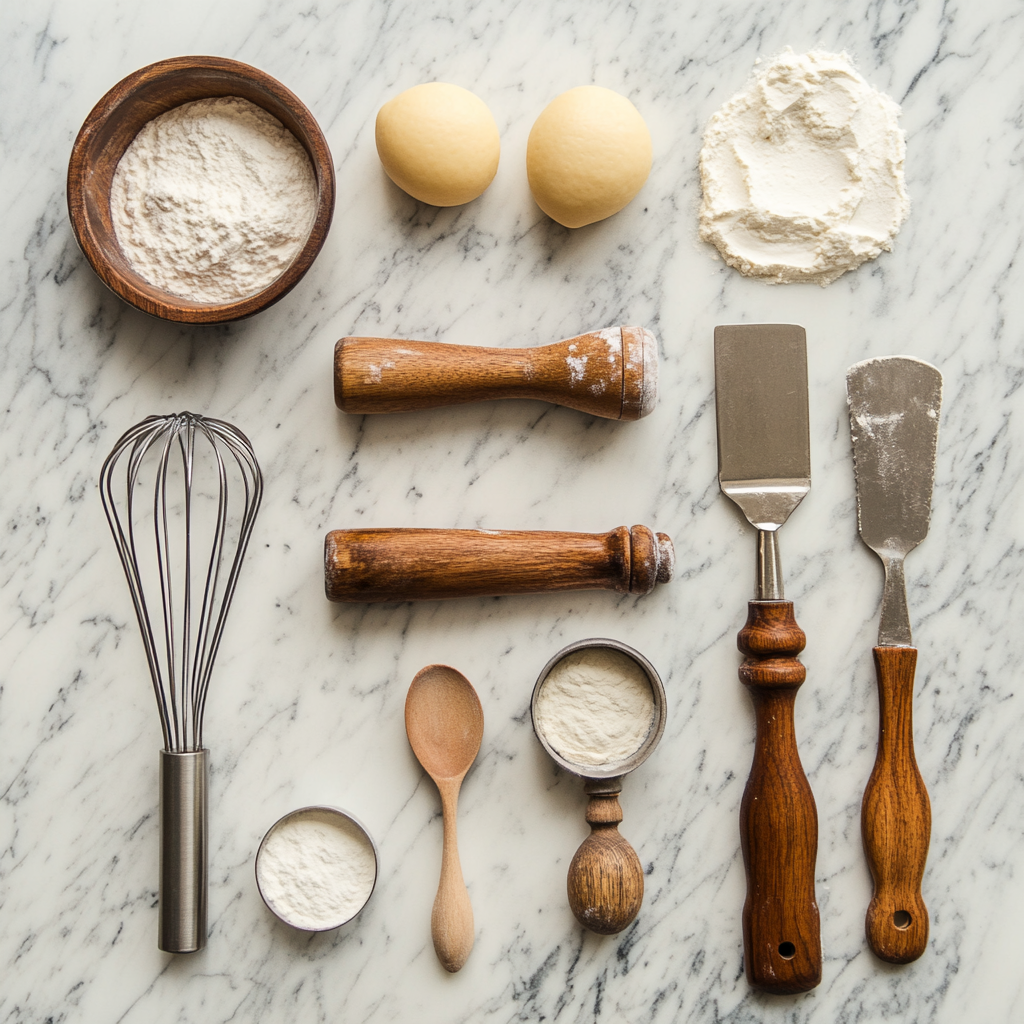
Before we get into shaping dough and chasing flakes, let’s get your kitchen ready. You don’t need a bakery’s arsenal—but a few smart tools make a massive difference when you’re crafting french breakfast pastries at home.
Must-Have Equipment for Beginners
If you’ve got a rolling pin and a baking sheet, you’re halfway there. But here’s what I wouldn’t bake without:
- Digital kitchen scale – Precision matters more in pastry than most places in cooking. Eyeballing flour just won’t cut it.
- Pastry brush – For that glossy, golden egg wash. It’s the difference between dull and stunning.
- Bench scraper – To fold dough cleanly, lift sticky layers, and scrape butter smears like a pro.
- Silicone baking mat or parchment paper – Keeps bottoms crisp, not scorched.
- Sharp knife or pizza cutter – For slicing neat triangles of croissant dough. Dull blades drag—your layers suffer.
If you’re curious how tools change depending on your breakfast approach, check out these no-fuss no-cook breakfast ideas for contrast. Same morning vibe, very different toolbox.
Pantry Staples for Classic Pastry Dough
Pastry dough is all about the chemistry between just a few ingredients. Stock up on these:
- All-purpose flour – Go for unbleached if you can.
- Unsalted European-style butter – Higher fat, less water. It’s what makes french breakfast pastries next-level.
- Active dry yeast – Reliable rise without overproofing.
- Whole milk – Adds richness and helps with tender crumb.
- Granulated sugar + salt – For balance and flavor depth.
Once you’ve got these, you’re ready to roll. Literally.
The Secret Behind That Flaky French Texture
You know that shattery crunch when you break open a proper croissant? That didn’t happen by accident. French pastry flakiness comes down to one thing: lamination. It’s a layering dance between dough and butter—and it’s way easier than it sounds once you feel it.
Understanding Butter’s Role in Pastries
Butter isn’t just a flavor player here—it’s a structural force. As you fold and roll the dough, that butter forms layers. When it bakes? The water in the butter steams, pushing those layers apart. That’s your flake factory right there.
But here’s the kicker: not all butter works. Use cold, high-fat butter with a lower water content (like Plugrá or Kerrygold). It gives the dough body and flavor without turning into a greasy mess.
And always chill between folds. Butter that melts into the dough ruins the whole deal.
How to Master Laminated Dough
If laminating sounds intense, let me be real: the first time I did it, I forgot to chill the dough after the second fold. It turned into one sticky, stretchy disaster. But I tried again. And again. The third batch? Nearly perfect.
Here’s the flow:
- Roll the dough into a big rectangle.
- Place your slab of cold butter in the center.
- Fold the dough over like a letter.
- Chill, roll, fold—repeat 2–3 times.
After that, your dough will look and feel like it’s full of secrets. Because it is.
Buttery Croissants That Actually Flake
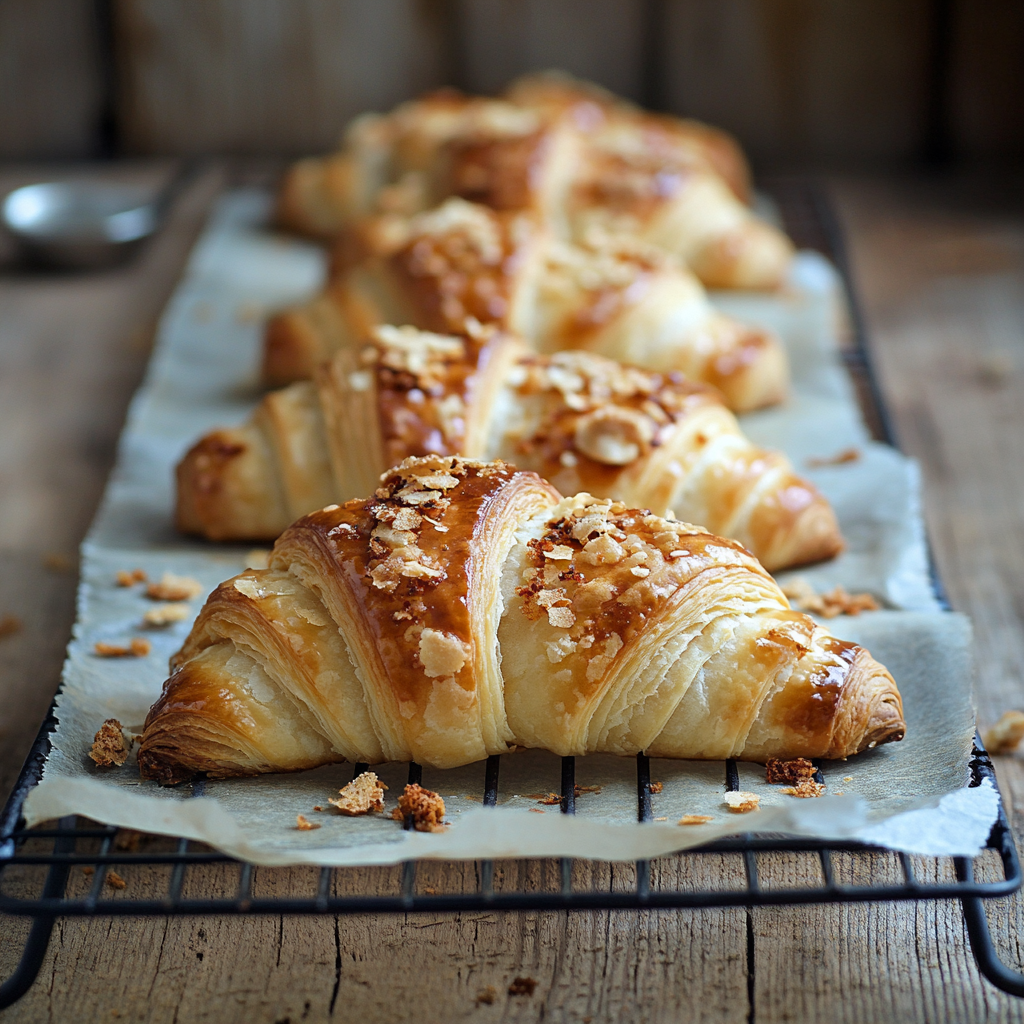
These croissants are worth the wait. And you know what? The process itself is kind of meditative. Rolling, folding, resting—there’s a rhythm to it that feels good. Like your kitchen breathing with you.
Prep Time: 1 hour (plus overnight chill)
Cook Time: 20 minutes
Total Time: About 12–14 hours
Servings: 8 croissants
Ingredients
- 2 ¼ tsp active dry yeast
- ¼ cup warm water
- ¾ cup warm milk
- 2 tbsp sugar
- 2 ½ cups all-purpose flour
- 1 ¼ tsp salt
- 1 cup cold unsalted European butter
- 1 egg (for egg wash)
Instructions
- Activate yeast: Mix warm water, warm milk, and sugar in a bowl. Sprinkle in the yeast. Let it foam for 10 minutes.
- Make the dough: Add flour and salt. Mix just until a rough dough forms. Do not overwork it. Chill 30 mins.
- Shape the butter: Slice butter and arrange into a square between parchment. Smash gently and chill.
- First fold: Roll dough into rectangle. Place butter in center. Fold dough like a letter. Chill 30 mins.
- Laminate: Roll, fold, chill—repeat this process 3 times. Wrap and chill overnight.
- Shape: Roll into a long rectangle. Cut into triangles. Roll each from base to tip. Place on lined baking sheet.
- Proof: Let croissants rise in a warm spot for 2 hours until puffy.
- Bake: Preheat to 400°F. Brush with egg wash. Bake 20 minutes or until golden and flakey.
Optional Tips:
- Want a sweet twist? Dust with powdered sugar post-bake.
- Prefer chocolate? Tuck a few chips inside before rolling.
- Need a faster fix? Check out these breakfasts for weight loss that skip the pastry wait.
Pain au Chocolat with Melty Centers
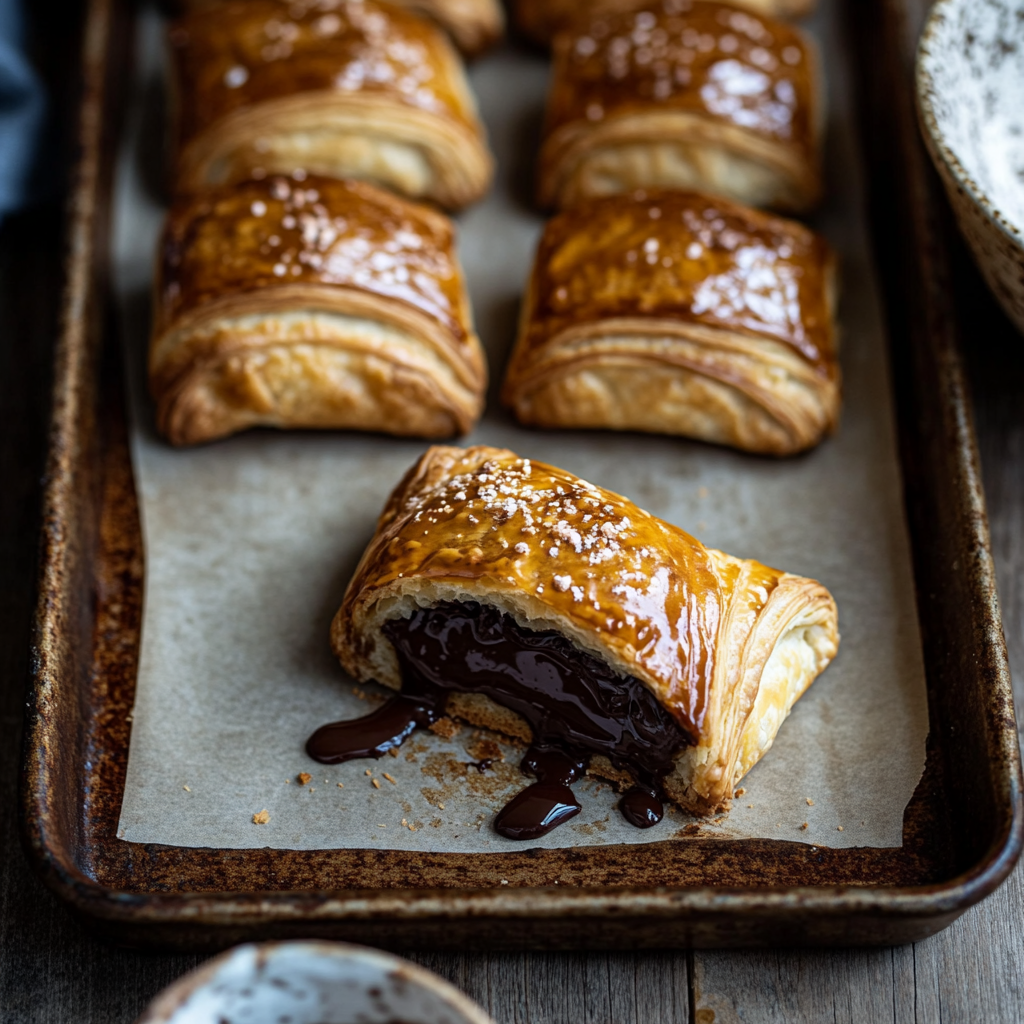
Pain au chocolat might just be the rockstar of French breakfast pastries. It’s everything you want in a bite: flaky, golden dough hugging warm, melty chocolate in the center. It’s got that “not too sweet, just right” thing going for it—and it’s surprisingly doable at home.
Prep Time: 30 minutes (plus overnight dough prep)
Cook Time: 20 minutes
Total Time: 12–14 hours with resting
Servings: 8 pastries
Ingredients
- 1 batch of laminated dough (same as croissant dough)
- 8 sticks of dark baking chocolate or batons
- 1 egg, beaten (for egg wash)
Instructions
- Roll and cut: Roll chilled dough into a rectangle, about ¼-inch thick. Cut into 4” x 6” rectangles.
- Add chocolate: Place one chocolate baton near the short edge. Roll once to cover. Place another baton and roll again to seal.
- Proof: Place seam-side down on a lined tray. Let rise in a warm spot for 2 hours until puffy.
- Bake: Preheat to 400°F. Brush tops with egg wash. Bake 18–20 minutes until golden and crisp.
- Cool slightly: Let them sit for 10 minutes so the centers firm up a bit—if you can wait that long.
Pro Tip: Want a shortcut for weekday chocolate cravings? Use store-bought puff pastry, cut into squares, add chocolate, roll, bake. It won’t be as layered, but it hits the spot.
Simple, Dreamy Chaussons aux Pommes
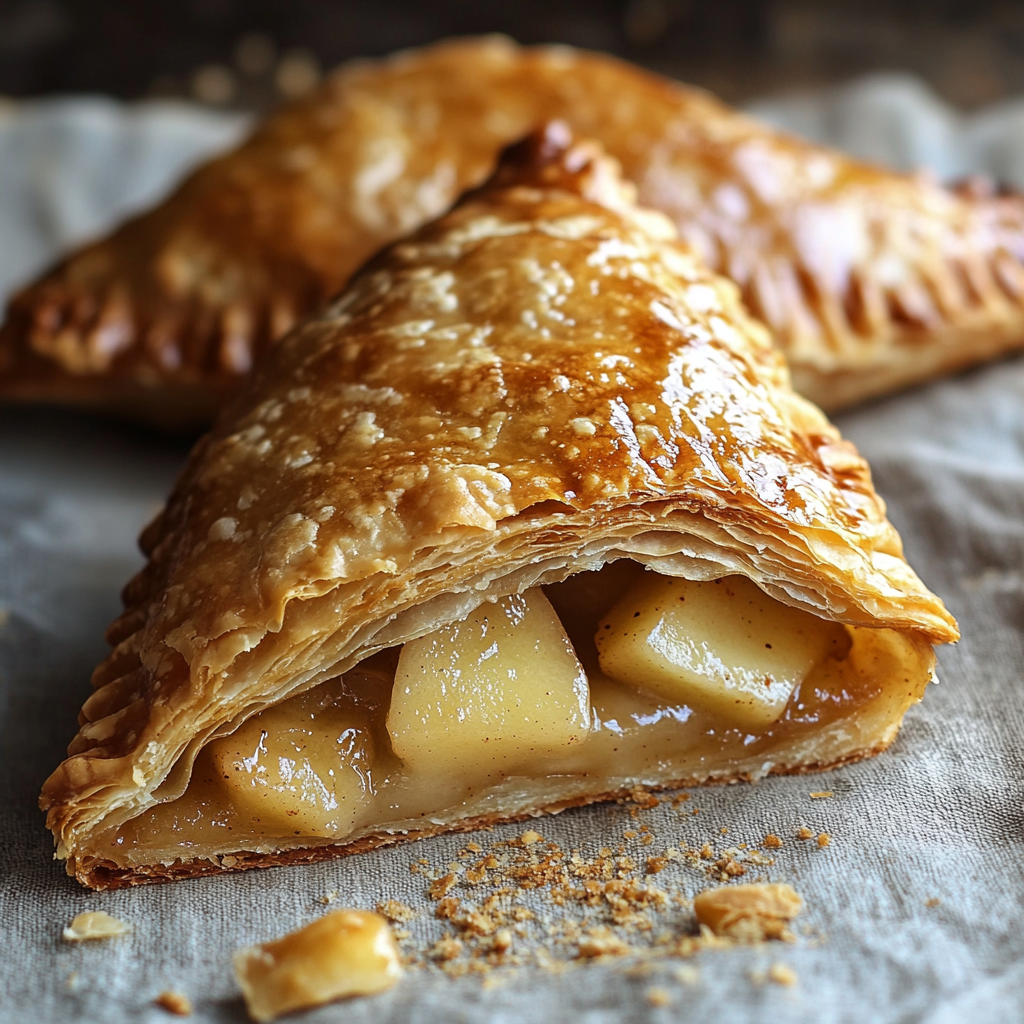
This one’s for the apple lovers. Chaussons aux pommes are like little hand pies—crisp, buttery pastry wrapped around smooth, spiced apple purée. Think of it as a pastry hug. Sweet, tart, warm… perfect with black coffee or chai.
Prep Time: 25 minutes
Cook Time: 20 minutes
Total Time: 45 minutes
Servings: 6–8 turnovers
Ingredients
- 1 sheet puff pastry (or use your croissant dough for richer texture)
- 2 medium apples, peeled and chopped
- 2 tbsp butter
- 2 tbsp brown sugar
- ¼ tsp cinnamon
- 1 egg, beaten (for egg wash)
Instructions
- Cook filling: In a pan, melt butter, add apples, brown sugar, and cinnamon. Cook until apples soften and sauce thickens. Cool.
- Shape: Roll out pastry and cut into circles using a bowl or cutter. Spoon cooled filling on one side. Fold over and crimp edges.
- Chill & bake: Chill turnovers 15 minutes. Preheat oven to 375°F. Brush with egg wash. Bake 20 minutes until golden and puffed.
- Optional glaze: Mix powdered sugar and water. Drizzle when pastries are warm but not hot.
It’s the kind of pastry that makes even rainy mornings feel cozy. And if you’re navigating dietary preferences, you’ll love this round-up of irresistible AIP breakfast recipes.
Common Mistakes (and How to Save the Batch)
Even seasoned bakers mess up when it comes to french breakfast pastries. But the good news? Most mistakes are totally fixable—or at least teach you something delicious.
1. Butter melts out of the dough
What happened: Dough got too warm during laminating or proofing.
Fix: Chill between every fold. If it’s hot in your kitchen, freeze the dough for 10 mins between steps.
2. Croissants didn’t puff
What happened: Yeast was dead or the proofing time was rushed.
Fix: Always proof in a warm (but not hot!) place. Use fresh yeast, and don’t skip the overnight chill.
3. Centers are doughy
What happened: Oven temp too low or overproofed.
Fix: Bake at high heat (375–400°F), and test doneness by tapping the bottom—it should sound hollow.
And hey, if it’s all just too much today, these delightful breakfast recipes for GERD are simpler but still special.
Make-Ahead Tips for Busy Mornings
Love pastries but not the 5 a.m. wake-up call? Same. Here’s how to prep your french breakfast pastries in advance without sacrificing quality:
- Freeze shaped dough: After shaping (but before proofing), freeze pastries on a tray. Once solid, store in bags for up to 2 months. Proof straight from frozen overnight in the fridge.
- Parbake & reheat: Bake croissants for 15 minutes, then cool and freeze. Finish baking (5–7 more minutes) in a 375°F oven straight from the freezer.
- Apple filling: Make and refrigerate up to 5 days ahead.
Weekday breakfasts just got a glow-up. And for something savory to balance the sweetness, try these chicken breakfast recipes for protein-packed variety.
How to Store and Reheat French Breakfast Pastries
Here’s the truth: French breakfast pastries are best the day they’re baked. But life gets busy, and you might not be pulling fresh chaussons out of the oven every morning. That’s okay—there’s a way to enjoy them later without sacrificing too much of that magic.
Storing Tips:
- Room Temp: Keep pastries in an airtight container for up to 2 days. Add a paper towel inside to absorb moisture and keep the crust crisp.
- Fridge: Only refrigerate if there’s cream or custard involved (e.g., certain danishes). Otherwise, it can dry out the dough.
- Freezer: Freeze fully baked pastries in a zip-top bag. Reheat straight from frozen.
Reheating Tips:
- Oven: Bake at 350°F for 5–8 minutes. This revives the outer flake and warms the center without drying.
- Toaster Oven: Ideal for single servings. Just avoid the microwave—it kills the crisp and turns butter layers rubbery.
Got extras? Consider pairing leftovers with these bariatric-friendly chicken recipes for a savory counterpoint.
Pairing Ideas: What to Drink With Each Pastry
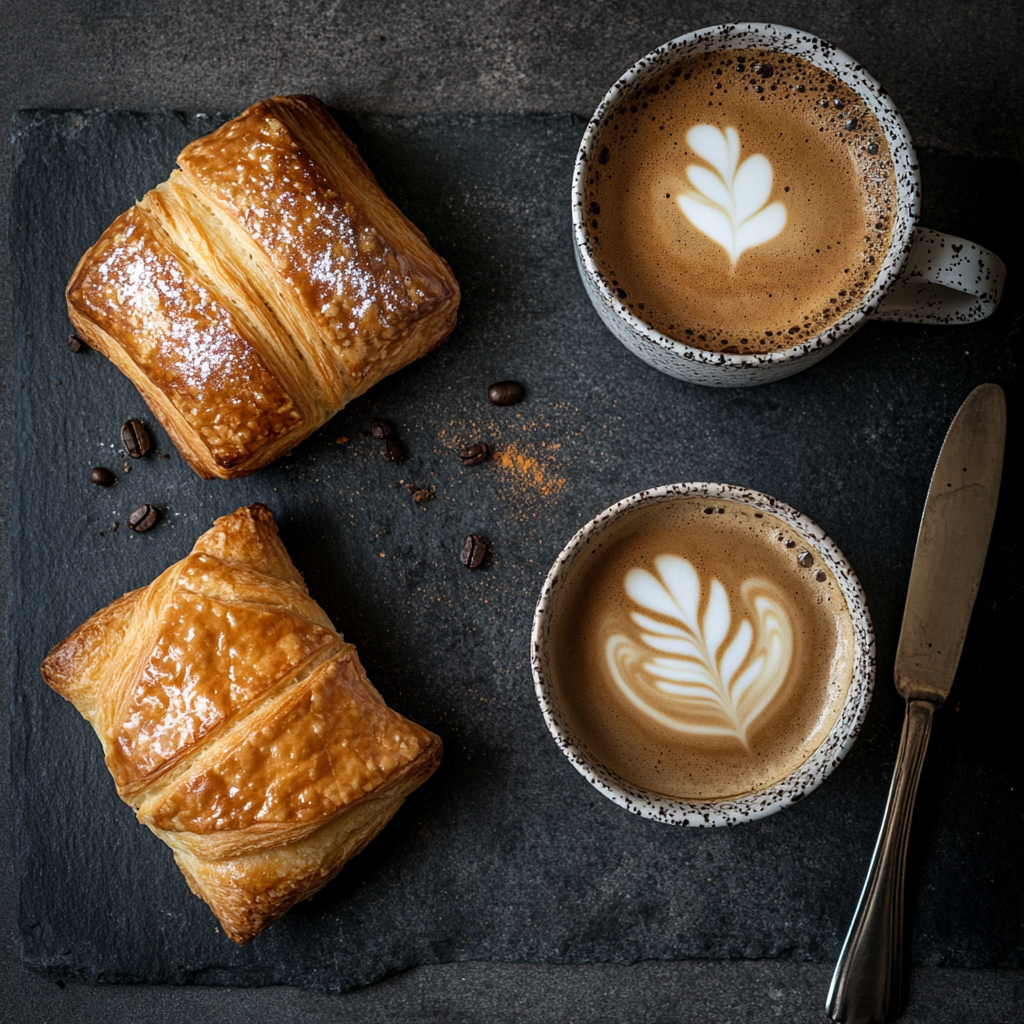
One of my favorite parts about enjoying French breakfast pastries is the pairing moment. A warm drink plus a warm pastry? That’s peak comfort.
Here are a few combos to try:
Croissant + Espresso or Café au Lait
The light bitterness of strong coffee cuts the butter beautifully. Add a splash of warm milk for richness.
Pain au Chocolat + Mocha or Hot Chocolate
Yes, more chocolate. The bitterness of dark cocoa plays off the pastry’s sweet center.
Chausson aux Pommes + Black Tea or Spiced Chai
The apple and cinnamon need something earthy to balance it. Try a strong Assam or even a lightly sweetened chai.
Almond Croissant + Iced Coffee with Milk
Nutty, sweet, and rich? Cool it down with a creamy iced brew. Even a cold brew with almond milk works here.
If you’re into matching your breakfast mood to your drink, there are tons of creative ideas in this list of breakfast picnic recipes. They make mornings feel like slow weekends—even when they’re not.
French Breakfast Pastries FAQ
1. What are the most popular French breakfast pastries?
Croissants and pain au chocolat top the list, hands down. They’re iconic, versatile, and relatively easy to find—or make. Chausson aux pommes, pain aux raisins, and brioche are also beloved classics.
2. Can I make French breakfast pastries in advance?
Yes! Most french breakfast pastries can be prepped the night before. Shape them, then chill overnight to proof slowly. In the morning, bake straight from the fridge.
3. What’s the difference between a croissant and pain au chocolat?
Same dough, different shapes and fillings. Croissants are crescent-shaped and often plain. Pain au chocolat is rectangular with chocolate tucked inside.
4. Can I freeze French breakfast pastries?
Absolutely. Freeze unbaked pastries after shaping or freeze fully baked ones. Either way, wrap them well and use within 2 months for best quality.
5. Why is European butter better for French pastries?
It has a higher fat content and lower water content. That means flakier layers and richer flavor. If you’ve got access to brands like Plugrá or Kerrygold, use them.
6. What pastries do the French eat for breakfast?
French breakfast tables often feature croissants, pain au chocolat, and brioche. Locals grab them fresh from a bakery, pair them with coffee, and enjoy them at home or a café. On weekends, you might also see pain aux raisins or chaussons aux pommes making an appearance.
7. What are the classic French pastries?
Some of the most classic French pastries include croissants, éclairs, mille-feuille (Napoleon), pain au chocolat, tarte Tatin, and madeleines. For breakfast specifically, laminated pastries like croissants and pain au chocolat reign supreme.
8. What is a typical breakfast in France?
A typical French breakfast is light but indulgent—think bread or pastries with butter and jam, sometimes yogurt or fruit, and a hot drink like café au lait. Eggs and savory dishes are less common compared to other cultures.
9. What are common breakfast pastries?
Common breakfast pastries around the world include croissants, danishes, sticky buns, cinnamon rolls, scones, and muffins. In France, croissants and pain au chocolat are breakfast staples. In the U.S., cinnamon rolls and danishes often dominate.
Conclusion
There’s something quietly luxurious about starting your day with french breakfast pastries. Whether you’re biting into a buttery croissant or spooning apple purée into a flaky chausson, these pastries make the morning feel like a pause—a celebration.
The beauty lies in the simplicity: flour, butter, time, and a little love. And while the techniques may take a try or two, the results are so worth it. They aren’t just baked goods. They’re golden pockets of warmth and intention.
So whether you’re mastering lamination or just heating a frozen one in the oven, you’re part of a tradition that spans centuries—and makes every bite worth savoring.
Have you made any of these at home? What’s your favorite way to enjoy them—hot from the oven or dunked into coffee? Share below. I’d love to hear how your mornings are changing, one pastry at a time.

